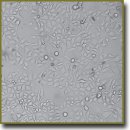
Effect of Ozone and Doxorubicin on the Viability and Morphology of Malignant Hepatic Cells
The aim of the investigation was to study the effect of isolated and combined action of ozone-oxygen mixture and doxorubicin on the viability and morphology of normal and malignant human hepatic cells.
Material and Methods. The culture of normal (Chang liver) and malignant (SK-HEP-1) human liver cells were used in the study. Doxorubicin and ozone-oxygen gas mixture were introduced to the culture medium for cell growth. Viability was tested by reduction of MTT tetrazole salts. Morphological investigations were carried out 48 h after the replacement of the cultural medium using DMIL HC inverted microscope (Germany).
Results. Doxorubicin possesses the highest cytotoxicity relative to both normal and malignant human hepatic cells. Ozone alone and in combination with doxorubicin also exerts a marked cytotoxic effect on the viability of the cells and results in irreversible consequences for the structure of the cell elements. The results obtained can be used for selection of ozone doses and ways of ozone introduction in various tumor localizations.
- Sweet F., Kao M.S., Lee S.C., Hagar W.L., Sweet W.E. Ozone selectively inhibits growth of human cancer cells. Science 1980; 209(4459): 931–933, http://dx.doi.org/10.1126/science.7403859.
- Wolf H.H. Das medizinische Ozon [Medical ozone]. Heidelberg; 1982; 250 p.
- Karlic H., Kucera H., Metka M., Schönbauer M., Söregi G. Effect of ozone and ionizing radiation on an in vitro model — a pilot study of 4 gynecologic tumors. Strahlenther Onkol 1987; 163(1): 37–42.
- Zanker K.S., Kroczek R. The mystery of molecule-ozone: antiproliferative, immunmodulative, synergistic to chemotherapy and carcinogenetic carcinogenic. In: IX Congress of Ozone. New York; 1989; p. 55–68.
- Arnan M., DeVries L.E. Effect of ozone/oхygen gas miхture directly injected into the mammary carcinoma of the female C3H/HEJ mice. In: Medical applications of ozone 1983; p. 101–107.
- Rodriguez Y., Bello J.L., Menendez S., et al. Antitumor activity of ozone. Experimental research. Ozone News 1997; 25(3): 50.
- Alyasova A.V., Kontorshickova K.N., Terentiev I.G., Ivanova I.P., Kuznetsov S.S., Sazanov A.I. Influence of the ozonized physiologic salt solution low therapeutic concentrations on a tumor therapeutic pathomorphosis in experiment. Sovremennye tehnologii v medicine 2010; 4: 27–32.
- Boyko N.N., Sen’kiv Yu.V., Shlyakhtina E.A., Klyuchivskaya O.Yu., Skorokhid N.R., Mitina N.E., Skorokhoda T.V., Moskvin M.M., Zaichenko A.S., Stoyka R.S. Action of doxorubicin delivered to tumor cells in vitro and in vivo by novel nanoscale oligoelectrolytic carrier. Biotechnologia Acta 2013; 6(3): 53–62.
- Zamulaeva I.A., Pronyushkina K.A., Matchuk O.N., Yabbarov N.G., Nikol’skaya E.D., Kondrasheva I.G. Combined effect of ionizing radiation and dendritic polymers, loaded by doxorubicin on the breast cancer cells of MCF-7 line. Radiatsionnaya biologiya. Radioekologiya 2015; 6: 591–597.
- Anikina L.V., Pukhov S.A., Dubrovskaya E.S., Afanas’eva S.V., Klochkov S.G. Comparative definition of cell viability by MTT and Resazurin. Fundamentalnie issledovania 2014; 12(part 7): 1423–1427.
- Mosmann T. Rapid colorimetric assay for cellular growth and survival: application to proliferation and cytotoxicity assays. J Immunol Methods 1983; 65(1–2): 55–63, http://dx.doi.org/10.1016/0022-1759(83)90303-4.










